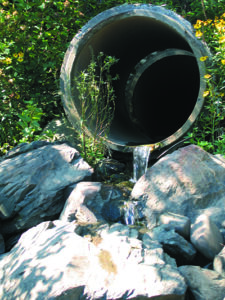Culvert Operations
Finding win-win solutions to improve management of Maine’s culverts
Put simply, the mission of the Maine chapter of The Nature Conservancy (TNC) is to conserve the lands and waters of the state on which all life depends. The Maine Department of Transportation (DOT) is concerned with providing the safest and most reliable transportation system possible, given available resources. Despite these contrasting goals, both organizations are lending their expertise to a new Mitchell Center project designed to help planners improve the management of tens of thousands of culverts underlying Maine’s vast road network.
And their input and expertise is critical to the project’s success! For example, DOT’s chief focus is on deciding when and where to repair or replace culverts, thereby minimizing the possibility of damage to roads from failing culverts. But many of the streams and rivers that get routed through culverts are also home to important species, including sea-run fish like salmon and alewife, that must pass through culverts to reach upstream spawning habitats. That’s where TNC’s greatest interests lie.
The Mitchell Center’s approach to improving culvert replacement strategies will enable municipalities to coordinate their plans for upgrading culverts on shared roads and streams to achieve greater environmental, public safety, and economic benefits than if they were upgraded without collaboration.
William Longfellow, Maine Dept. of Environmental Protection

elevated above the downstream water surface creating an impassable barrier for fish
As they age and degrade, culverts become more likely to fail and cause damage to roadways and surrounding property. Depending on when the culverts were installed and how conditions have changed, some culverts act as barriers to the upstream passage of fish. For example, the outlets of “hanging culverts” are elevated above the downstream water surface, which creates an impassable barrier for many fish. Other culverts are so narrow that the water rushing through them makes it impossible for fish to make their way upstream.
With funding from the Maine Water Resource Research Institute, a federal program administered by the Mitchell Center, the project, which is led by Sam Roy, a Research Assistant Professor in the Mitchell Center, is developing computer-based tools to identify culvert replacement strategies that yield the greatest payoff, not only in terms of increased road safety but also fish passage. In collaboration with Adam Daigneault and Shaleen Jain (both Mitchell Center faculty fellows), the project draws upon an uncommon blend of academic expertise, including environmental economics, public policy, hydrology, climate science, and civil engineering, all stitched together via state-of-the art methods for analyzing big data.
Given the large number of culverts within a single watershed – there are about 90 culverts underlying public roads in the average Maine town, or nearly 2 per mile of stream – it’s especially important to coordinate culvert replacement projects to achieve the biggest return on investment. For example, there is little benefit from replacing a single hanging culvert to improve fish passage if culvert “bottlenecks” located farther downstream continue to prevent sea run fish from reaching their spawning habitats. Similarly, many high priority roadways are underlain by multiple culverts. But it only takes one failing culvert to cause major traffic issues.
The tool under development will identify the culvert decisions that lead to the biggest improvements in both fish passage and infrastructure safety. A further priority is to minimize the cost of culvert replacements, which can easily exceed $50,000 for a typical culvert. Because there are more than 45,000 culverts in Maine, there are a lot of numbers to crunch. Fortunately, Roy is an expert in artificial intelligence, and he’s developed a machine learning genetic algorithm – an approach that would likely be over-the-head of the Avenger’s Tony Stark – to sort through all the options and find the best solutions.

“Our model allows planners to evaluate different strategies for coordinated decision-making that can provide significant improvements in passage and road safety at different budget levels,” Roy says. “For example, given an estimated budget and priority levels for roadway safety and fish passage, the tool provides a short list of culvert replacement projects that may achieve the greatest benefit. Existing planning tools are usually focused on one priority – either road safety or fish passage – but the opportunities for collaboration and cost sharing are much greater when both are considered at the same time.”
This culvert planning challenge is further complicated by the fact that the northeastern United States is experiencing much heavier rainstorms than in the past. For example, the number of storms per year that drop more than four inches of rain in 24 hours has increased four-fold over the last 40 years. The culverts that were installed decades ago, which have a typical design life of 50 years, aren’t wide enough to handle the increased run-off created by such extreme precipitation. When too much water tries to move through too narrow a culvert, it’s a recipe for road washout.

As a result, planners need to use larger culverts when they upgrade, which increases the price tag and places an even greater premium on finding cost-efficiencies through coordinated planning. The tool is designed with this in mind and includes options to anticipate what size culverts will be needed in the future.
There’s clearly a growing need for this kind of multi-purpose tool. For example, Maine voters approved a bond package that included $5 million for upgrades to culverts that increase public safety, water quality, and habitat for fish and wildlife. Municipalities, non-profit organizations, and other entities can apply for funds for culvert repair or replacement from the Maine Department of Environmental Protection (DEP). One important criterion by which these applications are evaluated is the cost-effectiveness of the proposed plan.
“The Mitchell Center’s approach to improving culvert replacement strategies will enable municipalities to coordinate their plans for upgrading culverts on shared roads and streams to achieve greater environmental, public safety, and economic benefits than if they were upgraded without collaboration. This will make Maine roads safer, have greater environmental benefits, and will make the best use of available funding,” says William Longfellow, Director of Innovation and Assistance at Maine DEP.
